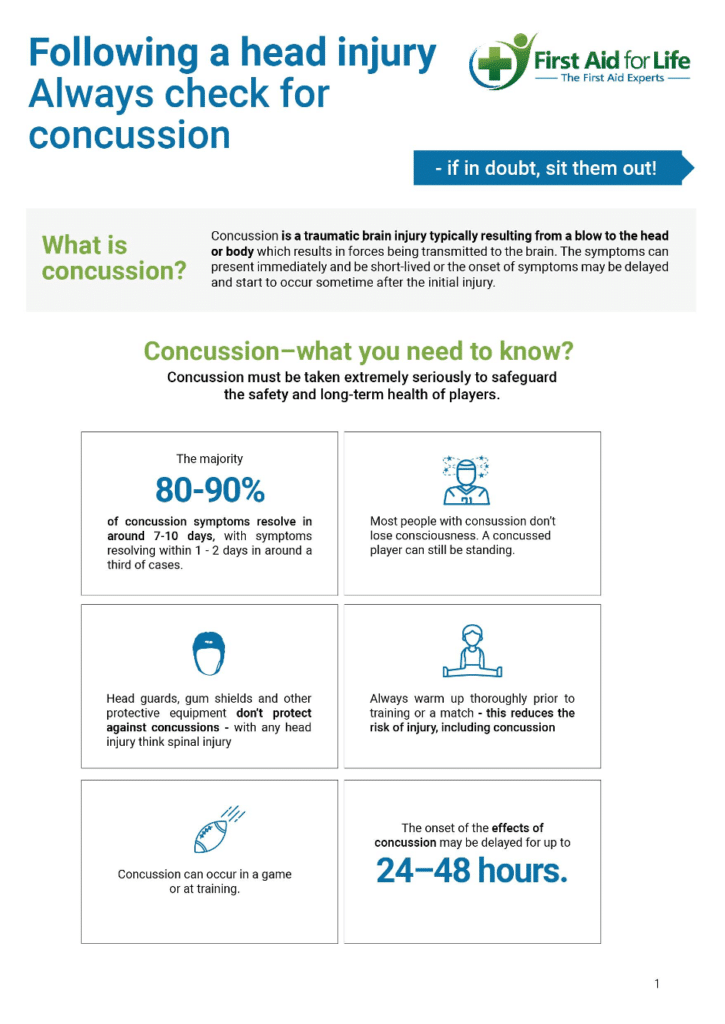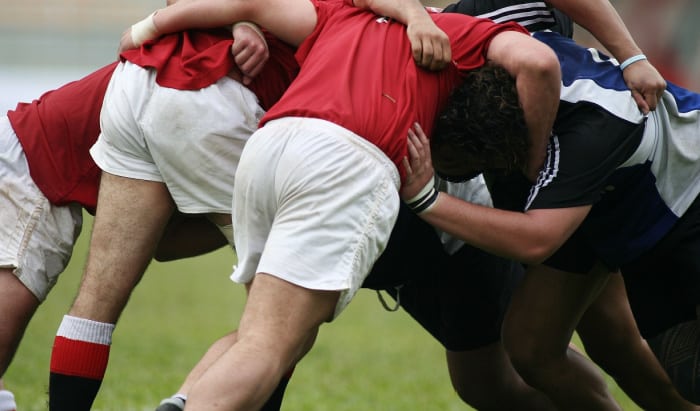This article has been written in accordance with the latest guidance from the RFA, England Rugby and the NHS.
There has been considerable research demonstrating a proven correlation between football and dementia. A report showed that former professional footballers are 3.5 times more likely to die with dementia and other serious neurological diseases.
Under-12s should no longer be heading the ball in training, however, this should not lead people to assume it is therefore safe for older children. Repeated head injuries are not good for our brains! Angus Hunter from Stirling University stated that when young people head the ball it causes electrical disturbances in the brain, disruption to muscles and a reduction in memory recall. When children head the ball in training, they are repeating the event multiple times and this can adversely affect their brains.
Dr Angus Hunter suggested that a softer lighter ball could cause less potential damage. This would reduce rates of concussions, which is far greater in children, and improve memory recall.
Old style leather footballs were particularly damaging, especially when wet.
Head injuries


When people bang their heads, it can be difficult to tell whether they have done any serious damage. Most head injuries are not serious and simply result in a bump or bruise. However, severe or repeated head injuries can cause damage to the brain.
Fortunately, the majority of falls or blows to the head result in injury to the scalp only. This is more frightening than life threatening – the head and face are served by numerous blood vessels and consequently these injuries bleed profusely and can be very scary!
It is very important to look out for anything unusual following a head injury as a severe bang on the head could cause swelling and damage to the brain and it is vitally important that you recognise any early and worrying signs of increased pressure on the brain.
First steps in the event of a head injury
For a child, look out for:
- Loss of consciousness
- Intense crying
- Trouble walking
- Complains
- of head and neck pain
If you see these signs, call 999 or 112.
If the casualty is not an infant, has not lost consciousness, and is alert and behaving normally after the fall or blow:
- Observe them carefully for the next 48 hours. No one should go home to an empty house for the 48 hours following a severe head injury. If you notice any of the signs of brain injury (see below), phone an ambulance immediately.
- Periodically apply a wrapped ice pack or instant cold pack to the injured area for 10 minutes to reduce superficial swelling.
- If the casualty is unusually drowsy or can’t be woken, or they show any symptoms of a brain injury (see below) call an ambulance immediately. People can go to sleep following a head injury, but only if they appear to be completely alert and showing no signs of confusion, losing consciousness or any other symptoms. If worried, seek medical attention immediately.
Suspected brain injury
The brain is cushioned by cerebrospinal fluid. However a severe blow to the head may knock the brain into the side of the skull or tear blood vessels.
It can be difficult to determine the level of injury, so it’s always wise to discuss a head injury with your doctor. A clear indicator of a more serious injury is when someone loses consciousness or has signs of confusion. These symptoms can come on at any time from immediately after the accident to a couple of days later. If it is a child that is injured it is sensible for them to sleep in the same room as you for a couple of nights following a head injury.
Signs of a serious head injury
Call an ambulance if someone shows any of these symptoms:
- Unconsciousness
- Abnormal breathing
- Obvious serious wound or suspected skull fracture
- Bleeding or clear fluid from the nose, ear, or mouth
- Disturbance of speech or vision
- Pupils of unequal size
- Weakness or paralysis
- Dizziness
- Neck pain or stiffness
- Fitting
- Vomiting more than two to three times – (it is not unusual for children to vomit immediately after an accident as a response to pain, so do not panic if an injured child is sick just once after a head injury).
What to do if someone is unconscious:
- If they are breathing – roll them into the recovery position (on their side so that their tongue falls forward in their mouth and any vomit can drain away), trying not to twist their neck or spine at all. Any head injury could have caused spinal damage as the head recoils from the blow.
- If they are not breathing start CPR.
- Call for an ambulance.
Most important advice following a head injury:
Visual signs of concussions, most common
symptoms in rugby or football players:
- loss of consciousness
- incoordination
- slow response time
- grabbing/ clutching head
- vomiting
- more emotional than usual
- tonic posturing. This is when they lie rigid or motionless because of a muscle spasms.
Symptoms that you may need to ask the person about:
- headache
- blurred vision
- fatigue
- drowsiness
- memory impairment
- sensitivity to light or sound
- difficulty concentrating
- nausea
- dizziness
Concussion can also affect someone’s mood, balance, sleep, thinking, concentration and senses. Most symptoms resolve in 7-10 days and many much sooner.
- Don’t make things worse – important to take seriously and rest
- Do not risk injury again
- Rest your brain = lots of sleep, avoid reading, screens and sports for at least 24 hours / 48 hours
Children and adolescents may need one or 2 days off school and a gradual return to academic study. They can start light reading and small amounts of screen time but should monitor and stop if there are signs of any recurrence of symptoms.
At least 2 weeks with no training to give the brain a chance to fully recover.
If there are no symptoms players can then start the gradual return to play or GRAS –
- 24 hours per stage (48 hours for children and adolescents) – go back a stage if symptoms occur
- Light aerobic exercise
- Sport specific exercise
- Non-contact training
- Full contact practice
19 days is the earliest that an adult can return to play
23 days is the earliest that a child or adolescent can return to play
Coaches and first aiders should be confident to:
Remove – any player who has experienced a head injury and shows any of the above symptoms should be removed from play immediately.
Remember RugbySafe’s mantra: IF IN DOUBT, LEAVE THEM OUT!
Recognise – learn the signs of concussion. Only about 10% of people experiencing concussion will actually be unconscious, therefore the other 90% of people who have experienced concussion will remain conscious. Look out for the more obvious signs such as a dazed or blank expression or tonic arm extension following the blow to the head; along with the symptoms listed above.
Applying a wrapped ice pack will reduce superficial bruising and swelling – but has no effect on any brain recovery.
If a severe head injury has been sustained and you are concerned about the casualty’s spine; they should only be removed from the field by someone appropriately trained to do so. If worried and no one appropriate to help; reassure the casualty, support their head in a neutral position, stop the game – or move to another pitch and await removal of the casualty by paramedics.
Rest – for at least 24 hours for an adult and 48 for a child or adolescent (see above)
Recover – Ensure the player remains completely symptom free before contemplating any form of return to play.
Return – return to play using the gradual return to play GRAS method.
Vital to recover
It may take 4-6 weeks before a player is fully fit and back to competitive play. This may seem a long time away from the game. However, it is comparable to the recovery time following a soft tissue injury and your brain is so important to every aspect of life, that it is vital we take head injuries seriously.
Repeated concussions
Players who experience 2 or more concussions in the space of a year should be reviewed individually.
They should ideally be seen by a doctor specialising in concussion management
Preventing concussions
Rugby players are often recommended to wear protective gear when playing or training. These include:
- mouthguards
- headguards
However it is important to note that there is no conclusive evidence that either of these reduce the risk of concussion.
Therefore the most efficient way to reduce the number of concussions is for players and coaches to examine the technique used whilst playing, in order to minimise damage. The vast majority of concussions, 60-70%, whilst playing rugby come from tackles.
The RFU have a superb online training course specific to parents, players, teachers and coaches. https://keepyourbootson.co.uk/rugbysafe-toolkit/headcase/
The Football Association have the following:
http://www.thefa.com/get-involved/coach/concussion
Free resource for monitoring recovery
To have access to this resource please visit the website or email emma@firstaidforlife.org
It is crucial to monitor recovery properly in order to prevent further damage.
New pitch-side saliva test can immediately diagnose concussion
The University of Birmingham, in association with the Rugby Football Union (RFU), Premiership Rugby and the Rugby Players’ Association have developed a new pitch-side test to quickly diagnose concussion and brain injuries. During matches in 2017-19, players with suspected or confirmed concussion were asked to provide samples of saliva immediately following the injury. The samples were then compared to samples taken from other players who did not sustain injuries. The test uses microscopic DNA markers in saliva to diagnose a concussion and it has a 94% accuracy.
This test may start being used for elite players in a few months and a pitch-side test that gives immediate results could be several years away. However, the test cannot yet be used for women due to a lack of data.
- What is a seizure? - 13th March 2025
- Febrile Convulsions and Seizures in Children - 13th March 2025
- Why women are less likely to receive CPR or survive cardiac arrest - 6th March 2025

